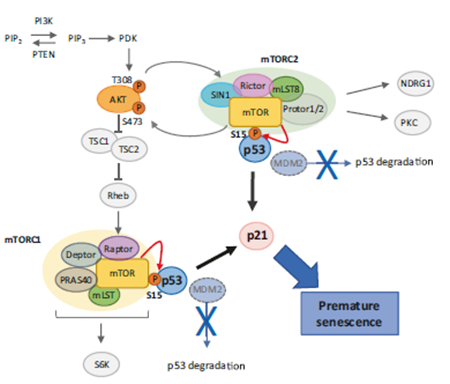글로벌 연구동향
방사선생물학
- [Oncogene.] mTOR kinase leads to PTEN-loss-induced cellular senescence by phosphorylating p53.mTOR의 AKT/p53 제어에 의한 암세포의 분열 및 노화조절 기전 규명
인하대 / 정승희, 이재선*
- 출처
- Oncogene.
- 등재일
- 2019 Mar
- 저널이슈번호
- 38(10):1639-1650. doi: 10.1038/s41388-018-0521-8. Epub 2018 Oct 18.
- 내용

Abstract
Loss of PTEN, the major negative regulator of the PI3K/AKT pathway induces a cellular senescence as a failsafe mechanism to defend against tumorigenesis, which is called PTEN-loss-induced cellular senescence (PICS). Although many studies have indicated that the mTOR pathway plays a critical role in cellular senescence, the exact functions of mTORC1 and mTORC2 in PICS are not well understood. In this study, we show that mTOR acts as a critical relay molecule downstream of PI3K/AKT and upstream of p53 in PICS. We found that PTEN depletion induces cellular senescence via p53-p21 signaling without triggering DNA damage response. mTOR kinase, a major component of mTORC1 and mTORC2, directly binds p53 and phosphorylates it at serine 15. mTORC1 and mTORC2 compete with MDM2 and increase the stability of p53 to induce cellular senescence via accumulation of the cell cycle inhibitor, p21. In embryonic fibroblasts of PTEN-knockout mice, PTEN deficiency also induces mTORC1 and mTORC2 to bind to p53 instead of MDM2, leading to cellular senescence. These results collectively demonstrate for the first time that mTOR plays a critical role in switching cells from proliferation signaling to senescence signaling via a direct link between the growth-promoting activity of AKT and the growth-suppressing activity of p53.
Author informationJung SH1,2, Hwang HJ1,2, Kang D1,2, Park HA1,2, Lee HC1,2, Jeong D3, Lee K3, Park HJ2,4, Ko YG5, Lee JS6,7.
1
Department of Molecular Medicine, College of Medicine, Inha University, Incheon, 22212, Korea.
2
Hypoxia-related Disease Research Center, College of Medicine, Inha University, Incheon, 22212, Korea.
3
Department of Biomedical Science, Hallym University, Chuncheon, Gangwon-do, 24252, Korea.
4
Department of Microbiology, College of Medicine, Inha University, Incheon, 22212, Korea.
5
Division of Life Sciences, Korea University, Seoul, 02841, Korea.
6
Department of Molecular Medicine, College of Medicine, Inha University, Incheon, 22212, Korea. jaeslee@inha.ac.kr.
7
Hypoxia-related Disease Research Center, College of Medicine, Inha University, Incheon, 22212, Korea. jaeslee@inha.ac.kr.
- 연구소개
- 방사선 혹은 항암제에 의해 유도되는 암세포 노화에서 AKT 활성화가 빈번하게 관찰됨. 한편 발암유전자가 유도하는 암세포 노화에서도 AKT 활성화가 신호전달경로의 중심분자임. 하지만 세포증식에 주요한 역할을 하는 AKT 분자의 활성화가 세포증식과는 상반된 개념의 세포노화를 어떻게유도할 수 있는 지에 대한 분자적 작용기전은 현재까지 전혀 알려지지 않았음. 본 연구에서는 AKT에 의해 mTOR1/mTOR2 분자가 동시에 활성화되고 p53에 직접적으로 결함함으로서 MDM2와 p53의 결합이 저해되고 최종적으로 p53 활성화에 의한 암세포 노화가 유도되는 분자적 작용기전을 최초로 증명함.
- 덧글달기










편집위원
mTOR pathway가 cellular senescence에 중요한 역할을 담당함이 알려져 있으나 PTEN-loss-induced cellular senescence (PICS)에서의 그 분작적 기전은 명확하지 않다. 본 논문에서는 mTOR가 PICS 단계에서 PI3K/AKT의 하위단계와 p53을 잇는 relay molecule로 작용함을 규명하였다. 이를 통해 mTOR가 proliferation signaling에서 senescence signaling로 전환되는 단계에서 핵심적인 역할을 수행함을 제안했다.
2019-04-17 16:06:42